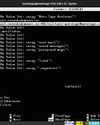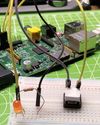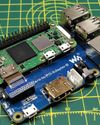SERIAL PERIPHERAL INTERFACE: Driving SPI displays
December 2021
|Linux Format
Let’s go on an adventure into the SPI protocol, LCD displays and model trains with Sean Conway toot-tooting away!

YOU NEED
Raspberry Pi Model 3B+
SD card 8GB or more
Pimoroni 1.3-inch SPI colour LCD (240x240) BR (Digi-Key PIM476)
Raspberry Pi OS Lite (4 Mar 21+)
Python ST7789 library to control an ST7789 TFT LCD display
Pillow Python Imaging Library
SPI is a synchronous serial communication interface specification that was developed by Motorola in the mid-1980s to provide full duplex (transmit/receive data in both directions) synchronous serial communication between controller and peripheral devices. Synchronous in protocols means that the communication is controlled by a controller (the Raspberry Pi) that talks to the peripheral – in this case an LCD device.
The SPI protocol defines no special bits to manage data. Limiting this overhead allows for high-speed data streaming. To provide some flexibility in communication, the serial clock has two options – Clock Polarity (CPOL) and Clock Phase (CPHA) – which, when configured, establish one of four modes.
In mode 0, data input/output occurs at the rising edge of the clock signal, where the clock polarity is low. For mode 1, data input/output occurs at the falling edge of the clock signal, where the clock polarity is low. To engage mode 2, data input/output occurs at the falling edge of the clock signal, where the clock polarity is high. In mode 3, data input/output occurs at the rising edge of the clock signal, where the clock polarity is high. CPOL and CPHA values are specified as ‘0’ or ‘1’ to form the four unique modes.
هذه القصة من طبعة December 2021 من Linux Format.
اشترك في Magzter GOLD للوصول إلى آلاف القصص المتميزة المنسقة، وأكثر من 9000 مجلة وصحيفة.
هل أنت مشترك بالفعل؟ تسجيل الدخول
المزيد من القصص من Linux Format

Linux Format
Create your first WebSocket service
Mihalis Tsoukalos explains how to use the Go programming language to work with the WebSocket protocol.
9 mins
April 2023

Linux Format
Fantastic Mr Firefox
Nick Peers takes a trip down memory lane to reveal the story behind the rise - and slight fall - of Mozilla's popular web browser.
9 mins
April 2023

Linux Format
Set up your terminal and email like it's 1983
Jump in the hot terminal time machine with Mats Tage Axelsson who emails from the command line using the latest technology.
8 mins
April 2023

Linux Format
Universal layer text effects with GIMP
Posters use them, films and presentations are hard to imagine without them: text effects. Attract attention with Karsten Günther and GIMP.
8 mins
April 2023

Linux Format
Jump to a federated social network
Nick Peers reveals how you can get up and running with this free, decentralised and non-profit alternative to Twitter.
9 mins
April 2023

Linux Format
Free our SOFTWARE!
Taking anything for granted is dangerous, so Jonni Bidwell and Mike Saunders revisit how the free software movement got started to help free us from proprietary tyranny!
4 mins
April 2023

Linux Format
Master RPI.GPIO
Les Pounder goes back to the early days of the Raspberry Pi - and his career with this classic library! -
5 mins
April 2023

Linux Format
Waveshare Zero to Pi3
Transform your Pi Zero into a Pi 3, they promised Les Pounder, but it's more like adding on go-faster stripes.
2 mins
April 2023

Linux Format
The Best OPEN SOURCE Software Ever!
In an attempt to trigger controversy, Michael Reed and Neil Mohr unequivocally state these are the greatest free software apps ever. Probably. We’re just trying to be helpful.
19 mins
April 2023

Linux Format
Linux-Mandrake 7
Simplicity and a wide range of applications make this a great distribution for all Linux users.
2 mins
April 2023
Translate
Change font size

